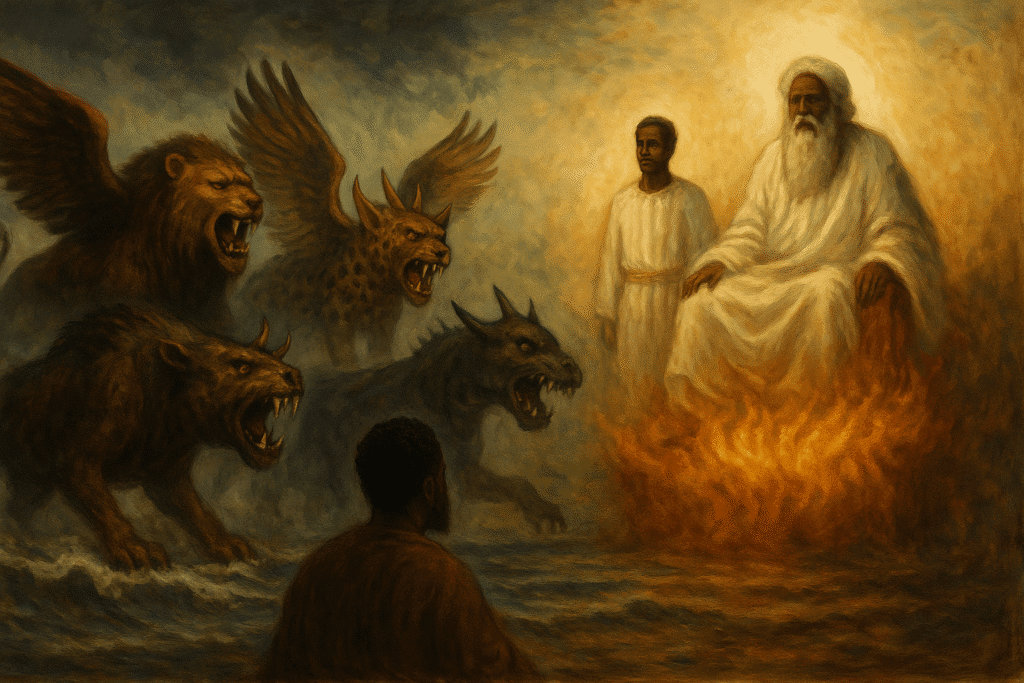Intro: Daniel Chapter 7 Summary
The Daniel Chapter 7 Summary unveils one of the most extraordinary prophetic visions in all of Scripture — a vision that, like the prophecies in Daniel Chapter 6, extends beyond the prophet’s own lifetime and reaches thousands of years into the future. In this chapter, Daniel witnesses four beasts rising from the sea, symbolizing a succession of world empires, followed by the appearance of the Ancient of Days and the Son of Man, whose eternal kingdom will never pass away.
📖 Read Daniel 7 (KJV)
🔗 Visit this site’s Summary of the Book of Daniel for a complete chapter-by-chapter study.
Daniel’s Vision of the Four Beasts
Daniel’s dream begins with four winds stirring up the great sea — a symbol of unrest among nations. From this chaos emerge four beasts, each representing a kingdom that will rise to power. The vision parallels Nebuchadnezzar’s statue dream in Daniel Chapter 2 but presents it from God’s perspective rather than man’s.
| Beast | Description (Daniel 7) | Corresponding Kingdom (Daniel 2) | Key Characteristics |
|---|---|---|---|
| Lion with eagle’s wings | Babylon | Head of Gold | Pride and splendor; wings plucked as Nebuchadnezzar was humbled. |
| Bear raised on one side, with three ribs in its mouth | Medo-Persia | Chest and Arms of Silver | Dual kingdom; Persia dominant; three ribs = conquered nations. |
| Leopard with four wings and four heads | Greece | Belly and Thighs of Bronze | Swift conquest under Alexander the Great; later divided into four kingdoms. |
| Terrifying beast with iron teeth and ten horns | Rome | Legs of Iron, Feet of Iron and Clay | Fierce, strong, and divided; ten horns = ten kingdoms that emerge after its fall. |
The beasts rise and fall, showing that human empires come and go, but each becomes more brutal and fragmented than the last. From gold to iron and from lion to monster, humanity’s glory decays as rebellion against God deepens.
The Ancient of Days and the Son of Man
After the final beast, Daniel sees a heavenly courtroom. The Ancient of Days — a title describing God’s eternal authority — takes His seat on a throne of fiery glory. The books are opened, and judgment begins. The last beast is destroyed, and dominion is transferred to “one like the Son of Man.”
| Symbol | Meaning | Scriptural Connection |
|---|---|---|
| Ancient of Days | God the Father, eternal and all-powerful, seated in judgment. | Revelation 4:2 – God enthroned in heaven. |
| Son of Man | The Messiah, Jesus Christ, receiving eternal dominion. | Matthew 26:64 – Jesus claims this title before the high priest. |
| Throne of Fire | Divine justice and holiness. | Hebrews 12:29 – “Our God is a consuming fire.” |
| Books Opened | Judgment and accountability before God. | Revelation 20:12 – The Book of Life. |
Daniel’s vision of the Son of Man is one of the clearest pre-incarnate revelations of Christ in the Old Testament — a prophecy Jesus directly referenced when describing His second coming.
Prophecy Fulfilled and Yet to Come
Parts of Daniel’s vision were fulfilled in his lifetime — Babylon’s fall and the rise of Persia — while others unfolded long after the biblical era. The Greek and Roman empires, and eventually the divided kingdoms of Europe, arose centuries later, precisely as foretold.
Prophetic Timeline
| Period | Event | Fulfillment |
|---|---|---|
| 605–539 B.C. | Babylonian Empire | Daniel’s lifetime; Nebuchadnezzar’s reign and humbling. |
| 539–331 B.C. | Medo-Persian Empire | Fulfilled in Daniel’s old age; Darius and Cyrus rule. |
| 331–146 B.C. | Greek Empire | Alexander’s conquest and division into four realms. |
| 146 B.C.–476 A.D. | Roman Empire | Christ born and crucified under Roman rule. |
| 476 A.D. onward | Divided Europe (ten kingdoms) | Fulfilled after Bible times; emergence of modern European nations. |
| Future | Eternal Kingdom of Christ | Yet to be fulfilled; the everlasting dominion of the Son of Man. |
Daniel saw not only the world’s kingdoms but their end — every empire eventually bows before the throne of God.
Prophecy Beyond Daniel’s Lifetime
Like the earlier prophecies in Daniel Chapter 6, Daniel’s visions in this chapter outlived him by centuries. He died serving Persian kings, having seen only the first stages of what God had revealed. Yet his vision extended across millennia — reaching from Babylon’s splendor to the rise of Rome and even into our modern world.
This chapter reminds readers that prophecy is God’s timeline, not man’s. The fulfillment of Daniel’s visions in history — long after the Bible was written — proves the divine origin of Scripture.
“The Most High ruleth in the kingdom of men, and giveth it to whomsoever he will.” (Daniel 4:17, KJV)
At the beginning of the final chapter of Daniel, this truth will echo again — the prophecies that began in his youth conclude with visions of resurrection and the end of days.
Application for Today
The Daniel Chapter 7 Summary teaches that earthly power, no matter how mighty, is temporary. God alone rules history. The beasts rise from chaos; the kingdoms crumble; but the Ancient of Days remains forever on His throne.
Daniel’s vision also offers comfort to believers: the Son of Man reigns eternally. When kingdoms fail and uncertainty grows, faith in Christ’s eternal dominion gives unshakable peace. Just as Daniel’s courage and vision sustained him in exile, this chapter reminds readers that God’s promises reach far beyond one lifetime.
Key Takeaway
Daniel saw what few others could — not just history unfolding, but eternity approaching. The four beasts fall, the thrones are cast down, and only one Kingdom remains: the everlasting Kingdom of God.
“And there was given him dominion, and glory, and a kingdom, that all people, nations, and languages, should serve him.” (Daniel 7:14, KJV)
